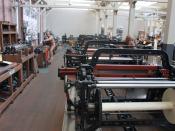The differences between these two production systems are very clear, in fact it can be said that they are the total opposite of each other in terms of their approach to, and methods of, production.
One of several aspects of the Toyota production system that differ from The GM system is that Toyota puts a flow into the manufacturing process, while GM has lathes located in the lathe area, milling machines in the milling area Toyota places a lathe, milling machine and a drilling machine in the actual sequence of the manufacturing process. This means that instead of having one worker per machine, one worker oversees many machines or processes. GM, however, has a group of workers skilled only in lathe operation, a group skilled only in milling. The GM plant layout will have 50 or more lathes in one location. When machining is completed the items are collected and taken to the subsequent drilling process, and after that the milling process.
In the US there is a union for each job function, with many unions in each company. Lathe operators are only allowed to operate lathes and a drilling job must only be taken to a drilling operator. As a result because the operators are single skilled a welding job required at the lathe section cannot be done there but must be taken to a welding operator. As a consequence there are a large number of people and machines and for GM, mass production is the only way to achieve cost reduction under such conditions. When large quantities are produced, the labour cost per car and depreciation burden are reduced. This requires high performance, high speed machines that are both large and expensive. This type of planned mass production is a system in which each process makes many parts...


